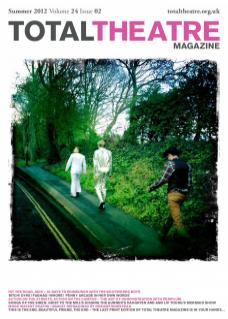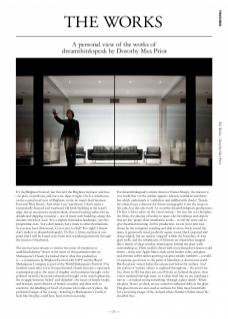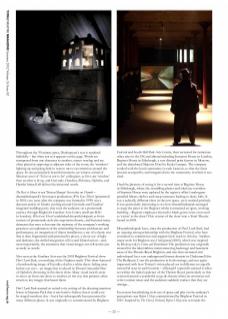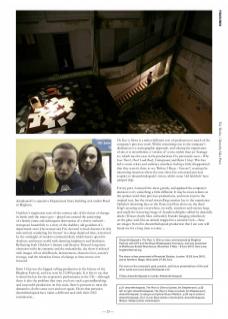It’s the Brighton Festival, but this isn’t the Brighton we know and love – no piers or pavilions, and not a tea-shop in sight. I’m in a warehouse, on the coastal road west of Brighton, in the no-man’s-land between East and West Sussex. And when I say ‘warehouse’ I don’t mean a romantically decayed and weathered old brick building at the water’s edge, but an anonymous modern block of metal looking rather like an abandoned shipping container – one of many such buildings along this desolate stretch of road. ‘It is a slightly featureless landscape,’ says the programme note, ‘not a destination, but a route to other destinations. As you may have discovered, it’s not easy to find!’ Too right! I almost don’t make it to dreamthinkspeak’s The Rest is Silence, and fear at one point that I will be found years from now wandering aimlessly through the streets of Southwick.
The site has been chosen to ‘mirror the sense of transition or undefined identity’ that is at the heart of this particular take on Shakespeare’s Hamlet, for indeed that is what this production is – a commission by Brighton Festival with LIFT and the Royal Shakespeare Company as part of the World Shakespeare Festival. Five hundred years after it was first performed, Hamlet remains a supremely contemporary play: the sense of fragility and transience brought on by political turmoil, the moral exhaustion brought on by social upheavals, the struggle between ‘belief’ and ‘disbelief’, the issues of family loyalty and betrayal, men’s distrust of female sexuality and their wish to control it, the labelling of ‘mad’ of anyone who talks out of place, the puritanical anger of the young – listening to Shakespeare’s words, it feels like this play could have been written yesterday.
For dreamthinkspeak’s artistic director Tristan Sharps, the interest is in a world that ‘on the surface appears relaxed, confident and shiny’ but which underneath is ‘rudderless and riddled with doubt’. Tristan has always been a director for whom scenography is not the icing on the cake, but the cake itself. As in earlier dreamthinkspeak productions, The Rest is Silence relies on the visual setting – the site, the set, the lights, the films, the placing of bodies in space, the furnishings and objects that are less ’props’ than installation works – to tell the story and to give theatrical meaning. In this production, we are (as in previous shows by the company) standing and able to move freely round the space (a generously sized, perfectly square room, black carpeted and sharp-edged), but we remain ‘trapped’ within the boundary of four glass walls, and the inhabitants of Elsinore are themselves trapped like a family of shop-window mannequins behind the glass walls surrounding us. Their world is fitted with everything their hearts could desire – shiny new Apple Macs, sleek white leather sofas, and glassand-chrome coffee tables sporting cut-glass whisky tumblers – a world of supreme good taste to the point of blandness, a showroom world. But the glossy veneer belies the unease just below the surface. And the notion of ‘surface values’ is explored throughout – the actors are live, there in 3D, but they are cut off from us, behind the glass, their voices rendered through mics, so it often feels like we are watching a movie – or indeed seeing something ‘through a glass darkly’. When the glass ‘boxes’ go dark, we see ourselves reflected dully in the glass. The glass fronts are also used as surfaces for film, most beautifully for a recurring image of the orchard where Hamlet’s father meets his dreadful fate…
Throughout the 90 minute piece, Shakespeare’s text is rendered faithfully – but often not as it appears on the page. Words are transposed from one character to another, scenes overlap, and are often played at opposing or adjacent sides of the room, the ‘windows’ lighting up and going dark in turn to move our attention around the space. In one particularly beautiful moment, we witness a kind of Mexican wave of ‘To be or not to be’ soliloquies, as first one ‘window’ then another is lit up, and Gertrude, Claudius, Polonius, Ophelia, and Hamlet himself all deliver the immortal words.
The Rest is Silence is not Tristan Sharps’ first take on Hamlet – dreamthinkspeak’s first major production, Who Goes There? (premiered in 2001, two years after the company was formed in 1999) was a deconstruction of Hamlet, circling around Gertrude and Claudius’ imagined wedding party, that took the audience on a promenade journey through Brighton’s Gardner Arts Centre (and later BAC in London). Who Goes There? established dreamthinkspeak as frontrunners of promenade-style site-responsive theatre, and featured many elements that were to become the mainstay of the company’s working practices: an exploration of the relationship between architecture and performance, an integration of object installation, a use of a classic text that is then fragmented and presented in pieces, a clever use of light and darkness, the skilful integration of live and filmed action – and, most importantly, the awareness that visual images can tell stories just as easily as words.
Also seen at the Gardner Arts was the 2003 Brighton Festival show Don’t Look Back, a reworking of the Orpheus myth. This show featured a heartbreaking image of Eurydice clad in a white dress, fading away before our eyes – an image that is echoed in Tristan’s beautiful film of Ophelia’s drowning in this latest show. Many visual motifs seem to move on from one show to another, in the way that painters often return to key images that haunt them.
Don’t Look Back seemed so suited to its setting of the decaying mansion house in Stanmer Park that it was hard to believe that it could ever be staged anywhere else – but it has subsequently been presented in many different places. It was originally co-commissioned by Brighton Festival and South Hill Park Arts Centre, then recreated for numerous other sites in the UK and abroad including Somerset House in London, Register House in Edinburgh, a vast disused print factory in Moscow, and the abandoned Majestic Hotel in Kuala Lumpur. The company worked with the local community in each location, so that the show become accepted by and integrated into the community in which it was sited. I had the pleasure of seeing it for a second time at Register House in Edinburgh, where the crumbling plaster and tiled airy corridors of Stanmer House were replaced by the registry office’s mahogany-panelled library shelves and steep staircases leading to dusty lofts. It was a radically different show in the new space, yet it worked perfectly. It was particularly interesting to see how dreamthinkspeak managed to stage the piece in the Register whilst it remained an open, working building – Register employees dressed in black gowns were even used as ‘extras’ in the show! This version of the show won a Total Theatre Award in 2005.
Dreamthinkspeak have, since the production of Don’t Look Back, had an ongoing strong relationship with the Brighton Festival, who have continued to commission and support their work to this day. Another major work for Brighton was Underground (2005), which was inspired by Dostoyevsky’s Crime and Punishment. The production was originally created for the labyrinthine interconnecting backstage and basement areas of the Theatre Royal Brighton, and was then recreated and redeveloped for a vast underground former abattoir in Clerkenwell (for The Barbican). I saw the production in both settings, and was again impressed with how Tristan’s vision played out in different yet equally successful ways in each location – although I especially enjoyed it when set within the faded opulence of the Theatre Royal, particularly as this version featured a wonderful coup-de-theatre where an enormous red velvet curtain raises and the audience suddenly realises that they are onstage…
Even more breathtaking in its use of space and play on the audience’s perceptions was Before I Sleep, commissioned by Brighton Festival in 2010. Inspired by The Cherry Orchard, Before I Sleep was set inside the abandoned Co-operative Department Store building on London Road in Brighton.
Chekhov’s tragicomic turn-of-the-century tale of the forces of change in battle with the status quo – played out around the auctioning of a family estate and subsequent destruction of a cherry orchard – transposes beautifully to a story of the doddery old guardian of a department store (the manservant Firs elevated to lead character in this reinvention) wandering his ‘manor’ in a sleep-deprived daze, terrorised by the onslaught of modern commercialism, which bursts upon his shadowy and musty world with alarming brightness and brashness. Reflecting both Chekhov’s themes and director Tristan’s long-time obsession with the romantic and the melancholic, the show is infused with images of lost childhoods, bereavement, obsessive love, nature’s revenge, and the relentless forces of change as time moves ever forward.
Before I Sleep was the biggest selling production in the history of the Brighton Festival, and was seen by 21,000 people. It is fair to say that it raised the bar for site-responsive performance in the UK – although there is also the problem that once you have such a groundbreaking and successful production on this scale, there is pressure to meet the demand to do the same over and over again. Given that pressure, dreamthinkspeak have taken a different tack with their 2012 commission…
The Rest is Silence is a rather different sort of production to much of the company’s previous work. Whilst remaining true to the company’s dedication to a scenographic approach, and valuing the importance of site, it is nevertheless a ‘version of’ a text, rather than an ‘homage to’, which was the case in the productions I’ve previously seen – Who Goes There?, Don’t Look Back, Underground, and Before I Sleep. This has led to some critics and audience members feeling a little disappointed that they weren’t there to see ‘Before I Sleep – Encore!’, creating the interesting situation where the new show has converted previous sceptics to dreamthinkspeak’s vision, whilst some ‘old faithfuls’ have jumped ship.
For my part, I enjoyed the show greatly, and applaud the company’s decision to try something a little different. It may be more reliant on the spoken word than previous productions, and more loyal to the original text, but the visual storytelling remains key to the experience: Ophelia’s drowning face as she floats (on film) above us; the dead king’s accusing eyes everywhere, on walls, monitors and screens large and small; the recurring image of Arcadian delights sullied by dastardly deeds (Tristan clearly likes orchards!); Hamlet banging relentlessly on the glass wall, like an animal trapped in a scientist’s lab – these are images from this dreamthinkspeak production that I am sure will haunt me for a long time to come…
Dreamthinkspeak’s The Rest is Silence was commissioned by Brighton Festival with LIFT and the Royal Shakespeare Company, and was presented at Malthouse Estate Warehouse, Shoreham 2 May – 8 June 2012. See www. brightonfestival.org
The show is then presented at Riverside Studios, London 12-23 June 2012, and at Northern Stage, Newcastle 27-30 June.
For more on the company’s past, present, and future presentations of this and other works see www.dreamthinkspeak.com
Follow dreamthinkspeak on twitter: #dreamthinkspeak



